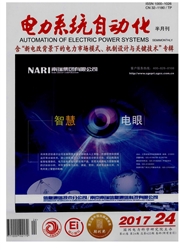

 中文摘要:
中文摘要:
随着多能源网络的融合与能源利用技术的进步,能源需求侧的能量管理受到了广泛关注,其中家庭耗能在能源需求侧占有相当大的比重。在此背景下,首先建立了以微型冷热电联产作为能源转化装置的家庭能源中心(HEH)的数学模型。其次,针对不同类型家庭电负荷的特性,将其细分为温度控制型电负荷、刚性电负荷、柔性电负荷,并建立了多类型电负荷的数学模型。接着,进一步将能源中心热负荷细分为热水负荷、空气制热/制冷负荷和电气可转换负荷,并建立了多类型热负荷模型。之后,引入温度舒适度和用电舒适度概念并用于指导HEH的温度控制和柔性电负荷控制。在此基础上,建立了以能源购买费用最小为目标,计及温度舒适度和用电舒适度的HEH混合整数线性规划模型。最后,以某家庭用户在冬季和夏季的典型日为例说明了所提出的方法的基本特征。
 英文摘要:
英文摘要:
With the merger of multiple energy networks and the advancement of energy utilization technology,demand-side energy management has attracted extensive attention.Residential energy consumption plays an important role in demand-side energy management.Given this background,a mathematical model of a home energy hub is presented first,with the micro combined cooling,heat and power(mCCHP)generation as the energy conversion device.Then,electrical loads are classified into temperature-controlling loads,inflexible loads and flexible loads,and their mathematical models developed with their characteristics considered.Then,thermal loads are classified into hot water demand,air heating/cooling demand and convertible loads between electricity and gas,and multiple types of thermal load models developed.The concepts of thermal comfort and electric comfort are next introduced and employed to control the temperature in the home energy hub.On this basis,the home energy hub with thermal comfort and electric comfort take into account is modeled as a mixed integer linear programming problem with the objective of minimizing the total energy cost.Finally,a typical winter day and a typical summer day of a household are employed to demonstrate the essential characteristics of the method developed.
 同期刊论文项目
同期刊论文项目
 同项目期刊论文
同项目期刊论文
 期刊信息
期刊信息
